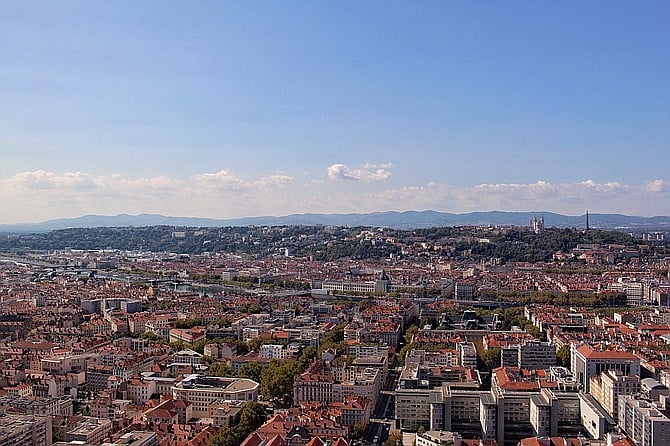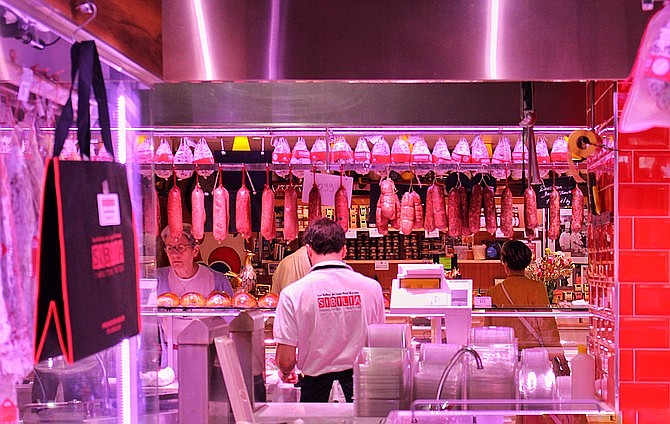 Facebook
Facebook
 X
X
 Instagram
Instagram
 TikTok
TikTok
 Youtube
Youtube

If Paris has its Seine dividing the city into Left and Right Banks, Lyon, France’s third largest city, is wedged in by two great rivers – the Rhône and Saône. From Paris, it’s a short two-hour high-speed train journey south.
Lyon is the jewel in the region of Auvergne-Rhone-Alpes. Its dynamic cultural life lends an air of sophistication as well the energy of a university town where talent and ideas surge and coalesce into one, like the rivers that flow through the city.

Arriving in Lyon, one has a feeling of taking part in a pilgrimage, navigating up and down and around a culinary mecca and stumbling upon a colony of chefs and gastronomy aficionados engaged in a ritual of food worship.
But the gourmet capital of France, or perhaps the world, isn’t just all about food – delicious-to-die-for-food – as any frequent traveler knows, it's also a place that captures a sense of visual discovery, and there are plenty of sights to take in.
Away from any talk of kitchen revolt, at Place Bellecour, the very heart of Presqu’ile or peninsula, all distances from the city are measured from here. A statue of Louis XIV presides in the middle of the square and not far is another statue paying homage to Lyon's illustrious son and author, Antoine de Saint-Exupéry. The open space invites revellers to simply laze around, engage in a conversation and just let the world go by.
A walk along Rue de la République feels like a miniature Paris with its Haussman-style apartment buildings. Lyon is like Paris on a more human scale. As all major French cities, the old and the new have found their way in some of the city’s architecture. Take the opera house, for example, considered as an "architecture tour de force" where the old structure is augmented by futuristic design of steel and glass barrel vaults. It represents the city's future aspirations, yet still connects with its roots.
Motion pictures were born in Lyon, courtesy of the Lumiere brothers. The city is also becoming a home to burgeoning art galleries and street art, where young artists from around the globe showcase photography, graphics and murals, exhibiting all year round.
For the art puritans, a modest collection of antiquities and works of Rodin, Matisse, Picasso, Rubens and several French impressionists can be found in the city's Fine Arts Museum.
Lyon's historic quarter is a maze of streets and unmarked passageways known as traboules running perpendicular to the river. Originally used by merchants to speed things up when transporting goods along the river and back, the traboules also became vital assets for the resistance during the Nazi occupation in France.
When in Lyon, you must ascend to the hilltops of Fourvière via a furnicular ride, which offers a panoramic vista of the city and a close-up view of Notre Dame de Fourvière, Lyon’s most iconic monument. It is a long-distant cousin of Montmartes’ Sacrè-Coeur Basilica in Paris.
Just a few meters from the Basilica are the remains of a Roman colony that established a community here around 43 BC. A grand theater spread out on an empty field as students sprawled with their backpacks were busy picnicking on baguettes, wines and cheese.
To travel to Lyon and see the city induces a distinct feeling of nostalgia and a certitude of coming back. Lyon can instantly become a fitting escape not only for pilgrims in search of culinary perfection as well as those who wish to immerse themselves in a city up close through visual experience that benefit the hungry soul.


If Paris has its Seine dividing the city into Left and Right Banks, Lyon, France’s third largest city, is wedged in by two great rivers – the Rhône and Saône. From Paris, it’s a short two-hour high-speed train journey south.
Lyon is the jewel in the region of Auvergne-Rhone-Alpes. Its dynamic cultural life lends an air of sophistication as well the energy of a university town where talent and ideas surge and coalesce into one, like the rivers that flow through the city.

Arriving in Lyon, one has a feeling of taking part in a pilgrimage, navigating up and down and around a culinary mecca and stumbling upon a colony of chefs and gastronomy aficionados engaged in a ritual of food worship.
But the gourmet capital of France, or perhaps the world, isn’t just all about food – delicious-to-die-for-food – as any frequent traveler knows, it's also a place that captures a sense of visual discovery, and there are plenty of sights to take in.
Away from any talk of kitchen revolt, at Place Bellecour, the very heart of Presqu’ile or peninsula, all distances from the city are measured from here. A statue of Louis XIV presides in the middle of the square and not far is another statue paying homage to Lyon's illustrious son and author, Antoine de Saint-Exupéry. The open space invites revellers to simply laze around, engage in a conversation and just let the world go by.
A walk along Rue de la République feels like a miniature Paris with its Haussman-style apartment buildings. Lyon is like Paris on a more human scale. As all major French cities, the old and the new have found their way in some of the city’s architecture. Take the opera house, for example, considered as an "architecture tour de force" where the old structure is augmented by futuristic design of steel and glass barrel vaults. It represents the city's future aspirations, yet still connects with its roots.
Motion pictures were born in Lyon, courtesy of the Lumiere brothers. The city is also becoming a home to burgeoning art galleries and street art, where young artists from around the globe showcase photography, graphics and murals, exhibiting all year round.
For the art puritans, a modest collection of antiquities and works of Rodin, Matisse, Picasso, Rubens and several French impressionists can be found in the city's Fine Arts Museum.
Lyon's historic quarter is a maze of streets and unmarked passageways known as traboules running perpendicular to the river. Originally used by merchants to speed things up when transporting goods along the river and back, the traboules also became vital assets for the resistance during the Nazi occupation in France.
When in Lyon, you must ascend to the hilltops of Fourvière via a furnicular ride, which offers a panoramic vista of the city and a close-up view of Notre Dame de Fourvière, Lyon’s most iconic monument. It is a long-distant cousin of Montmartes’ Sacrè-Coeur Basilica in Paris.
Just a few meters from the Basilica are the remains of a Roman colony that established a community here around 43 BC. A grand theater spread out on an empty field as students sprawled with their backpacks were busy picnicking on baguettes, wines and cheese.
To travel to Lyon and see the city induces a distinct feeling of nostalgia and a certitude of coming back. Lyon can instantly become a fitting escape not only for pilgrims in search of culinary perfection as well as those who wish to immerse themselves in a city up close through visual experience that benefit the hungry soul.
Comments